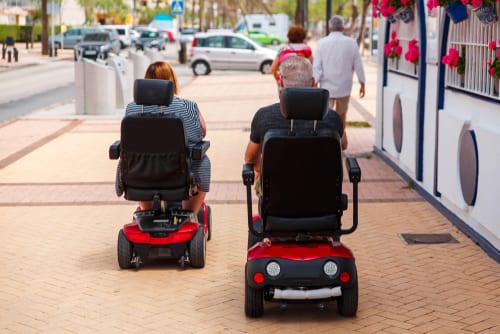A SURVEY has revealed that the poor condition of footpaths is the single biggest safety concern for mobility scooter users in Victoria.
The Blue Badge Mobility Scooter Safety and Insurance Survey also revealed that 30 percent of mobility scooter users in Victoria had been involved in an accident at some point and 50 percent were involved in a near accident at least once a year.
The survey, conducted by Australia’s first mobility insurance specialist, Blue Badge Insurance, comes as the number of mobility scooters on our footpaths climbs rapidly, driven by Australia’s ageing population.
There are currently 120,000 mobility scooter users Australia-wide with numbers growing at around nine percent annually and expected to reach 280,000 within ten years.
Of those surveyed, when asked about the infrastructure in their local area, 63 percent said uneven footpaths were an issue, 59 percent said cracks in the footpaths were a barrier to getting around and 46 percent complained about the lack of road ramps.
Another major concern for 37 percent was cars reversing out of driveways and 31 percent said they felt at risk when crossing the road.
“Mobility scooters have transformed the lives of many elderly and less able,” said Blue Badge Insurance CEO, Nikolas Witcombe.
“In a society where mobility is key to independence and freedom, mobility scooters mean those who would otherwise be housebound and isolated from society, can now get around without having to rely on anyone to get them there.”
“The Blue Badge Mobility Scooter Safety and Insurance Survey showed that most mobility scooter users are perfectly confident when it comes to operating their device, but it is external factors out of their control they fear most,” he said.
“Councils need to maintain footpaths and provide ramps to protect riders from having to use the road.
“And for the community, there’s a clear and simple message; keep an eye out for mobility scooters.
“Motor vehicle drivers need to be more alert as the low profile of these mobility scooters can make them hard to spot.
“As a whole, if everyone just took more notice, then fewer accidents would happen.”
Public Awareness Tips
- Keep an eye out for mobility scooters as you go about your day.
- Double check footpath traffic when reversing your car, particularly from driveways
- If you encounter a mobility scooter on the road, slow down and allow at least a metre gap when passing them in your car
- Give mobility scooter users plenty of time to cross the road
- As a pedestrian, be prepared to give way to scooters if the footpath narrows or is under construction
- Don’t obstruct access — keep your bins off the footpath
- Keep vegetation in front of your house maintained so it doesn’t encroach onto footpaths
For Mobility Scooter Users
- Be seen — it’s important to stay visible so consider purchasing safety equipment including flags, lights and reflectors
- Watch out for vehicles leaving and entering driveways, never assume the driver has seen you
- Stick to footpaths. Only ride on roads if there is no footpath and ensure you can be seen
- Only cross roads at pedestrian crossings and wait for the green light
- Don’t block pedestrian access when you park your mobility scooter
- Adjust your driving to the conditions and don’t use slopes that are too steep for your mobility scooter
- Make turns slowly and approach ramps and kerbs head on
- Keep the load down — don’t carry too many parcels
This article was sourced from Swan Hill Guardian published on Wednesday, April 1, 2015








